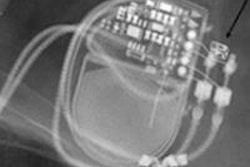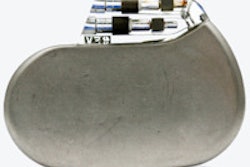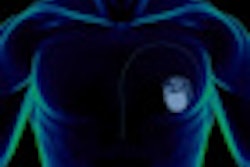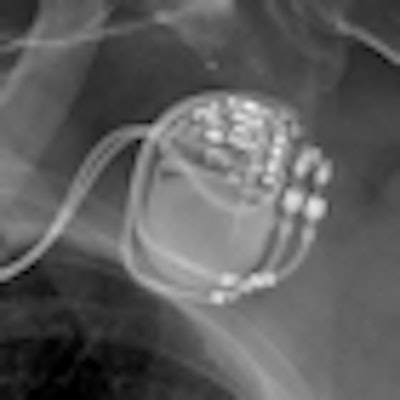
The emergence of MRI-compatible pacemakers has revolutionized management of patients with indications for which MRI is the gold standard, but this relatively new clinical combination of pacemaker with MR systems means that radiologists are often only partially aware of the risks associated with it.
MRI-compatible pacemakers are only conditionally safe for use with MR systems, according to Dr. Josef Vymazal, head of radiology at Prague's Na Homolce Hospital. He has scanned 40 patients with such pacemakers over the past three years, making him one of the most experienced specialists involved in this field, and he points to several precautions that must be taken before an MR scan.
First, an initial standard x-ray will allow radiologists to check that the pacemaker is MR-conditional, not conventional, and that the correct electrodes (or "leads") are present. Energy from the magnetic field transforms into heat and may be conducted by the electrodes into the heart. Such a temperature increase in a standard pacemaker may damage the myocardium and cause necrosis, one reason for disqualifying MRI in these cases. In an MR-conditional pacemaker, however, this temperature increase should be minimal due to differences in the electrodes' composition and will not cause damage.
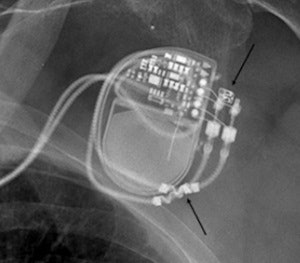 A pre-MRI x-ray allows visual confirmation of electrode placement and integrity, implantable pulse generator position, and MR-conditional radiopaque markers. Top arrow indicates radiopaque emblem of an MR-conditional pacemaker. Bottom arrow indicates appropriate electrodes or "leads" with MR-conditional wavy radiopaque markers. Image courtesy of Dr. Josef Vymazal.
A pre-MRI x-ray allows visual confirmation of electrode placement and integrity, implantable pulse generator position, and MR-conditional radiopaque markers. Top arrow indicates radiopaque emblem of an MR-conditional pacemaker. Bottom arrow indicates appropriate electrodes or "leads" with MR-conditional wavy radiopaque markers. Image courtesy of Dr. Josef Vymazal.
"So far it is unclear whether or not the electrodes can be replaced at a later stage by different noncompatible ones, by error, for example. I am only happy when I've seen with my own eyes through a simple x-ray that all is as it should be. This is my first precaution," he explained.
The cardiologist or cardiotechnician must then switch the pacemaker from a standard to an MR-conditional pacing mode -- a fixed rate and frequency that are not sensitive to the external influence of magnetic fields. With conventional cardiac pacemakers, strong magnetic fields in the MR environment may interfere with the rhythm of the pacemaker, causing life-threatening dysrhythmia, another reason why MRI is prohibited, and why emergency patients even with the new device can't be sent systematically for an MR scan. Verifying the printed, dated statement from the appropriate professional therefore remains a key precaution, providing the radiologist with certainty that the pacemaker has indeed been switched into fixed mode.
Routine clinical use of these new breeds of pacemaker is not yet widespread, according to Vymazal, who took part in the clinical trial of the first commercially available pacemaker, the Medtronic EnRhythm MRI SureScan pacing system. Since its approval for 1.5-tesla MRI in Europe in 2008, other MR-conditional pacemakers have appeared on the market, and more are expected to follow.
Given that around 2 million Europeans already have pacemakers, as well as increasing indications for MRI and growing numbers of pacemaker implants, patient triage and safety are already becoming a more complex issue. It could take several years for new procedures to become established, requiring heightened awareness, specific training, and system changes.
At Na Homolce Hospital, the addition of an extra field in the MRI request program to describe the new status of MR-conditional pacemakers now means that the software does not automatically prevent a radiologist from continuing with a request if a patient has a pacemaker. Furthermore, staff at several centers in the Czech Republic are being trained so that patients with MR-conditional pacemakers can be safely scanned at their local hospitals.
The transition decade ahead, when patients with both types of pacemaker may present for an MRI scan, could be challenging for radiologists, and Vymazal is keen to highlight the potential risks posed by the overlap.
"The biggest danger is for an emergency doctor to read in someone's notes that this patient with a pacemaker had a recent MR scan and then assume that it's OK to perform a second one without following the correct steps," he noted.
However, with the safety of the device relatively well established, Vymazal urges radiologists to proceed with a healthy mix of confidence and caution, citing no adverse events to date at his hospital.
"A prescan x-ray will increase confidence. Document and verbal checks remain crucial, as does monitoring of vital functions during the scan. What we need to know now is how safe the device is from human tampering, such as accidental changing of electrodes to noncompatible ones," he said.




